Surface Frizz – The Bane of Our Stylish Existence!
Updated on
This post may contain affiliate links. As an Amazon Associate, we may earn from qualifying purchases.
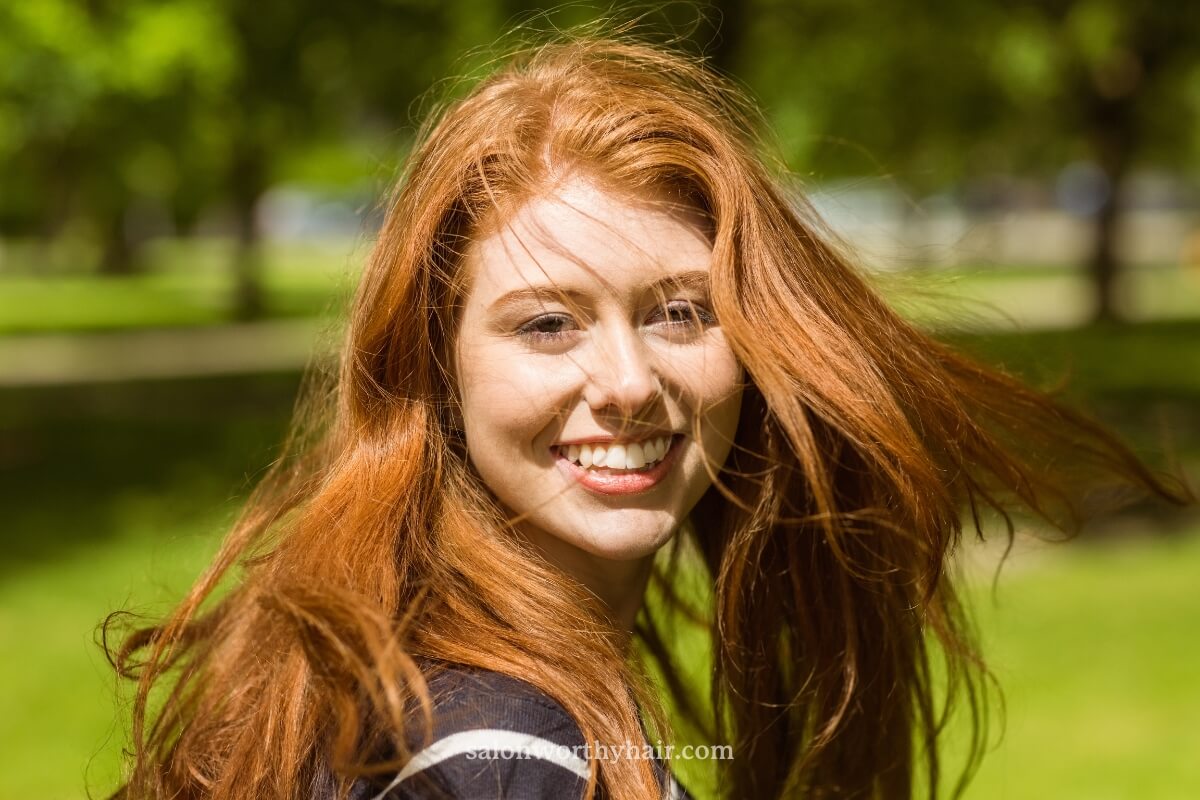
But the moment you step outside, the forces of nature conspire against you. The humidity decides to have a little fun, the wind whispers “Not today, my friend,” and suddenly, your meticulously styled masterpiece turns into a frizz-tastic disaster.
Suddenly, your hair looks like it’s been styled by an overzealous, frizz-obsessed raccoon, and just like that – it transforms into a sentient being of its own, laughing at your futile attempts to achieve hair perfection.
Instead of looking sleek and polished, your hair appears like a chaotic dance of rebellious strands hovering over the surface of your mane.
Hello, surface frizz!
We’ve all had these types of bad hair days, and I know it’s not going away.
So let me show you how to be in total control of your hairstyle and prevent surface frizz from ruining it.
Table of Contents
- What is Surface Frizz?
- What Does Surface Frizz Look Like?
- What Causes Surface Frizz?
- How to Get Rid of Surface Frizz Fast
- How to Prevent Surface Frizz
- Start with a Good Shower Routine
- Avoid Over-Brushing
- Use a Heat Protectant When Heat Styling
- Choose the Right Styling Products
- Embrace Hairstyles That Hide Frizz
- Embrace a Healthy Hair Care Routine
- Protect Your Hair from the Elements
- Sleep on a Silk or Satin Pillowcase
- Get a Regular Haircut
- Get a Keratin Treatment
- Best Products to Fix Surface Frizz Fast
What is Surface Frizz?
Surface frizz is a type of hair frizz that mainly occurs on the outermost layer or “surface” of the hair. It can also be referred to as peripheral frizz or exterior frizz that manifests on the outer layers or edges of the hair, particularly those close to the face, ears, and neck. These areas are more exposed and visible, making them prone to frizz, flyaways, and environmental factors like humidity and wind.
One common trait of surface or exterior frizz is that it often appears as floating flyaways of rebellious strands, refusing to conform to the uniformity of the rest.
Surface frizz can affect all hair types but may be more noticeable in certain hair textures.
What Does Surface Frizz Look Like?
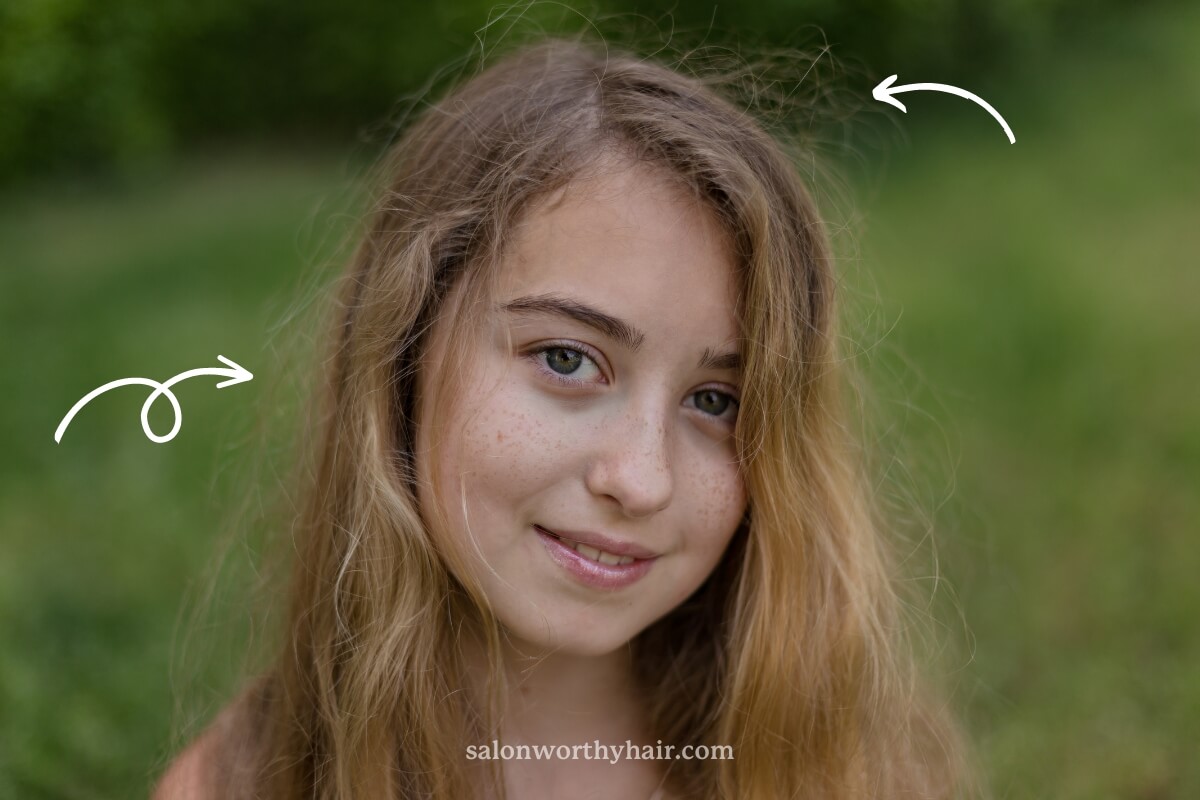
Surface frizz looks like loose flyaways where individual hair strands deviate from the rest due to damage, static electricity, and hair texture.
These rogue, disobedient hairs around the periphery of the hair may intertwine with neighboring strands, forming a complex network of curls and zigzags. Others stick out defiantly as if declaring their independence from the rest of the hair.
On straight hair, surface frizz appears as individual strands of hair that have detached from the smooth, aligned structure of the rest of the hair. These hair strands form a thin, uneven layer of fuzziness in certain areas, such as around the hairline, the crown of the head, or along the hair’s length.
On curly or wavy hair, surface frizz appears as individual strands or small groups of strands that have separated from the defined curls or coils, disrupting the curl definition and making the hair appear less defined.
Halo frizz is another example of frizz on the hair’s surface but mainly hovers around the crown area due to uneven hair lengths. It encircles the head like a radiant crown, showcasing the true glory of the disobedient strands.
What Causes Surface Frizz?
Surface frizz occurs when some hairs are more frizzy than others due to lack of moisture, lack of length to blend in with the rest, breakage, split ends, or damage. As a result, these individual hairs extend and stray away from the rest to seek moisture.
Various factors can lead to frizzy outer layers on the hair, including humidity, styling products, and how you care for your hair.
Below are some of the most common causes:
Uneven Distribution of Moisture
Uneven moisture distribution in the hair can leave some parts drier than others. This can happen due to inconsistent application of hair products, exposure to heat or chemicals, and uneven distribution of natural oils from the scalp. As a result, the drier sections get frizzy and protrude from the main body of the hair.
To reduce surface frizz, it’s essential to maintain a balanced moisture level throughout the hair.
Split Ends and Damage
Split ends occur when the hair shaft splits or frays due to damage, breakage, or excessive wear and tear. These splits result in uneven hair lengths and textures, causing individual strands to deviate from the main body of hair, leading to frizz on the surface.
Damaged hairs are also more porous and susceptible to frizz, disrupting the hair’s natural smoothness and alignment and causing surface frizz. As a result, the hair shaft swells and pushes the already-lifted cuticles further apart, exacerbating the frizz. In addition, these lifted cuticles create more friction between hair strands, leading to increased tangling and breakage.
Uneven Hair Lengths
Uneven hair lengths resulting from a bad haircut, trim, or razor cuts can contribute to surface frizz by causing an inconsistent hair structure. When hair is cut unevenly, it creates varying layers and lengths throughout, which disrupts the hair’s overall uniformity. This unevenness makes it difficult for the hair strands to lay flat and align, leading to a frizzy surface.
In the case of razor cuts, the sharp blades can cause the hair shaft to fray, creating jagged ends that won’t lay flat with the rest of the hair.
Read: How to fix a bad razor haircut that is making your hair frizzy.High Humidity

When the outside humidity is more concentrated than the moisture content in your hair, the humidity moves into areas of low concentration, which is your hair. This unexpected gulp of hydration causes the hair to swell and twist, creating frizz.
Brushing and Combing
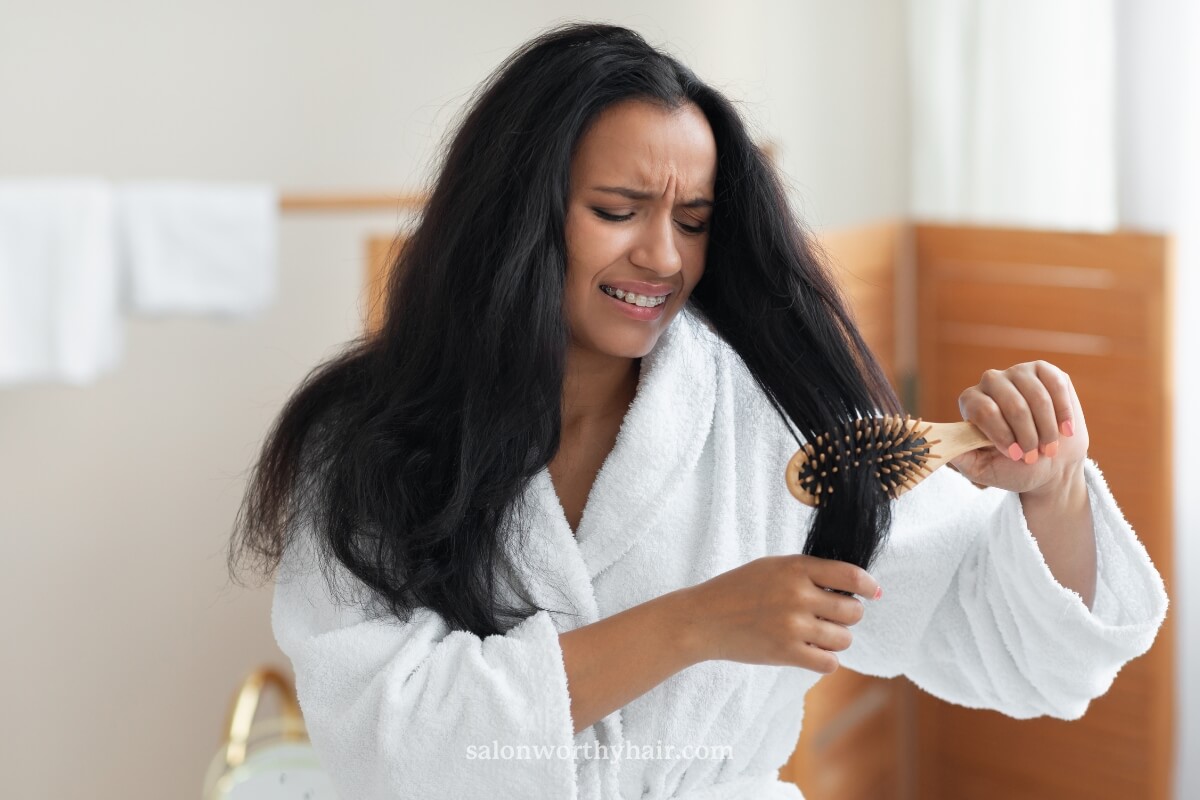
Excessive brushing or combing can also cause exterior frizz that often looks like statics. This seemingly innocent grooming practice can often lead to a full-blown frizz uprising. As we run the brush or comb through our hair, a tiny but powerful electrical charge builds up, causing our strands to repel each other like magnets of the same polarity. This static electricity transforms our once well-behaved locks into a gravity-defying spectacle of surface frizz.
Hair Products
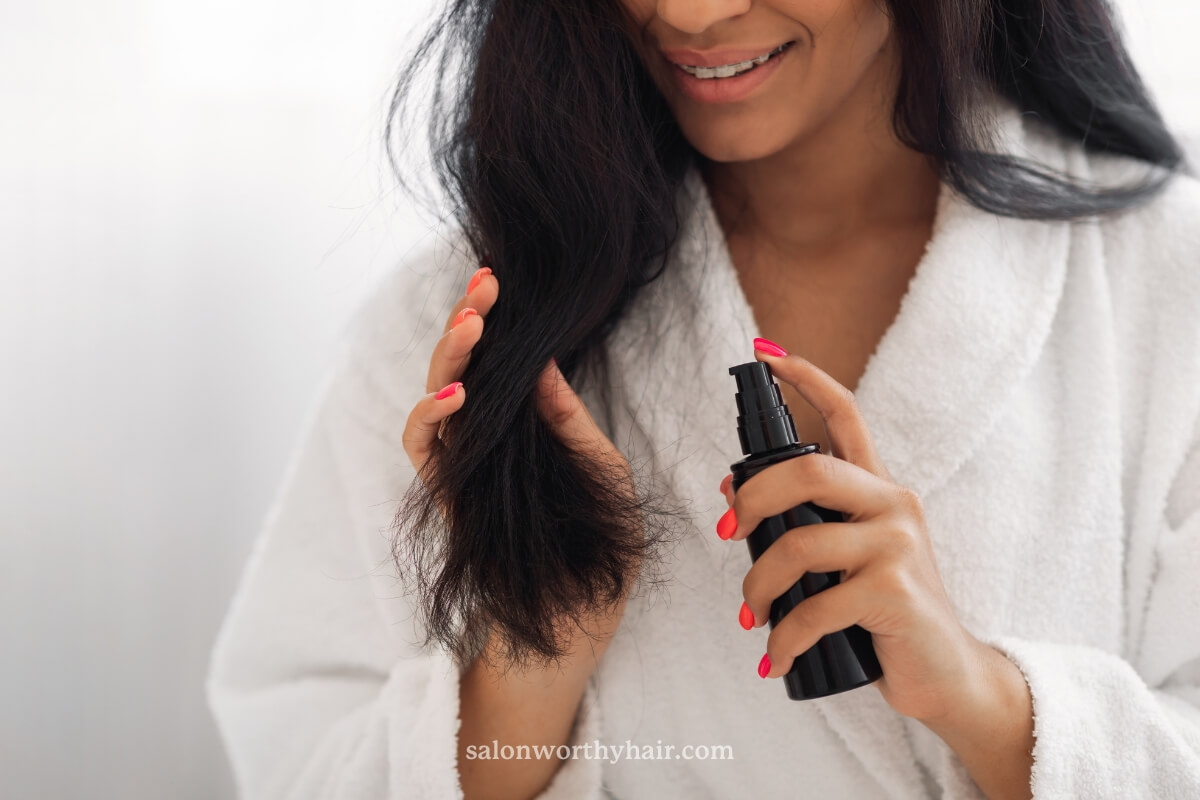
We must not overlook the influence of hair products and their roles in causing frizz. Overusing, misusing, or using the wrong products can make your hair spring forth with frizz.
Sulfate-based shampoos, for example, can leave your locks feeling dehydrated due to their harsh surfactants designed to dissolve and remove oil and dirt from the hair and scalp.
Hot tools can swell the hair’s cuticle layer, causing the damaged hair strands to clump together and cling to each other. This is a surefire way to cause hair frizz.
Alcohol in hair products evaporates quickly, which helps set the hair in place. This evaporation process can strip the hair of its natural oils and moisture. Alcohol is a volatile compound that evaporates rapidly at room temperature. When applied to the hair, the alcohol evaporates, absorbing moisture and heat from the surrounding area, including the hair shaft. This rapid evaporation leads to a drying effect on the hair.
Cold and Dry Weather – Static

According to Marilisa Sears, Artistic Director for Marc Anthony True Professional, “cold places have dry heat,” and this causes the air to have very little moisture. As a result, the lack of moisture in the air can cause hair to become dry, brittle, and more prone to breakage, leading to frizz.
Dry winter weather can cause static in hair because when the air is dry, it lacks moisture and negatively charged ions. As a result, the hair becomes positively charged, which leads to static.
They repel each other, and that causes them to stand up instead of clumping uniformly with the rest of the hair.
How to Get Rid of Surface Frizz Fast
To get rid of surface frizz fast, use lightweight anti-frizz hair products to moisturize, smoothen, and protect the hair from humidity.
Use Anti-Frizz Hair Sheets
One of my favorite products for taming surface frizz is anti-frizz hair sheets. They are small, discreet, easy to carry around, and work in less than a minute!
In a pinch, you can use a dryer sheet to help tame frizz. Gently run the dryer sheet over the surface of your hair to reduce static and smooth out frizz. This temporary fix can be helpful if you’re in a hurry.
Recommended: Best anti frizz hair sheets.Use a Mascara Wand
A mascara wand is a versatile tool that can effectively tame surface frizz and flyaways in various situations, providing a polished and sleek appearance. It is particularly useful for refining updos and formal hairstyles, managing post-workout frizz, taming baby hair, refreshing second-day hair, and enhancing braids or twists. To use a mascara wand for fixing surface frizz, ensure it is clean and free from residual mascara.
For added effectiveness, spray a small amount of hairspray or apply lightweight hair oil to the bristles. Gently brush the wand over the frizzy areas with a light touch to avoid disrupting the hairstyle or causing breakage. The mascara wand helps smooth and tame hair for a refined, polished look.
Dampen and Reset
If your hair is only mildly frizzy, try dampening it slightly with a water spray bottle, and then smooth out the frizz using your hands or a wide-tooth comb. After that, you can use a low-heat hairdryer with a diffuser attachment to dry and set your hair in place.
Use a Hair Mist or Serum
Apply a lightweight hair mist or serum specifically designed to combat frizz. Use your hands to gently distribute the product over the surface of your hair, focusing on the areas with the most frizz. Ensure not to use too much product as it might weigh your hair down.
Redken Anti-frizz Serum
Try a Leave-In Conditioner
A leave-in conditioner can help tame frizz by providing long-lasting hydration, sealing cuticles, and protecting hair from external factors. Leave-in conditioners contain humectants, emollients, and occlusive agents like glycerin, silicones, and shea butter to keep the hair’s moisture balanced and the cuticle layer smooth and sealed.
Apply a small amount to your hands, rub them together, and gently smooth over the frizzy areas.
Briogeo Farewell Frizz Leave In Conditioning Spray
Use a Lightweight Oil
Use a lightweight oil to gently smooth it over your frizzy hair. Oils like argan and almond oil are excellent at smoothing the hair’s cuticle layer while boosting moisture. They can also add shine, soften the hair, and control frizz without making it greasy.
Josie Maran Argan Oil
Use an Anti-Frizz Hairspray
Use a lightweight hair spray to help control frizz and hold your hairstyle in place. Spray it onto a brush or your hands, then smooth it over your frizzy areas.
These are the instant fixes for surface frizz that has already occurred. If you want to stop it from happening, continue reading below for my prevention tips.
Colow WOW Dreamcoat
Get a Trim
A hair trim can help fix surface frizz by removing split ends and promoting a more uniform hair length. Cutting off the damaged portions of hair eliminates the rough, raised cuticles that contribute to frizz. This allows the remaining hair strands to lie flatter and smoother, reducing the appearance of surface frizz.
Additionally, a trim can help balance uneven hair lengths that might be causing individual strands to deviate from the main body of hair. By creating a more even and consistent hair structure, the trim reduces the chance of stray strands sticking out and contributing to frizz.
Also Read: How to get rid of frizzy hair – tips and tricks.How to Prevent Surface Frizz
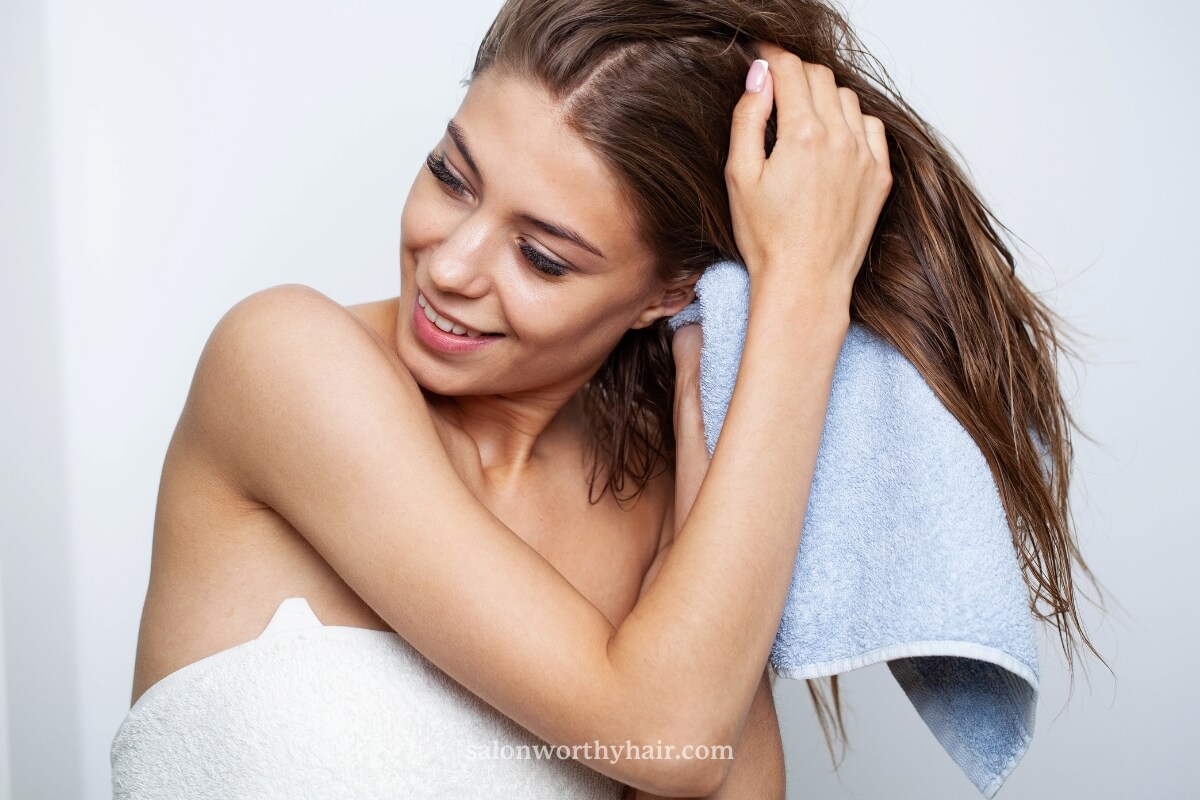
To prevent surface frizz, it’s essential to keep the hair hydrated, use styling techniques that don’t create friction, adopt hairstyles specifically designed to reduce the appearance of frizz, and use appropriate hair care products designed to keep frizz under control in unpredictable weather conditions.
Let me show you how:
Start with a Good Shower Routine
A good shower routine is essential for keeping the hair hydrated.
Use sulfate-free moisturizing shampoos that won’t strip your hair and alternate with a clarifying shampoo once a week for deep cleansing. Always follow up with a conditioner and detangle your hair while it’s still saturated with the conditioner.
When drying your hair, avoid using a cotton towel. Use a microfiber towel or a cotton T-shirt instead. This will minimize friction and prevent the hair cuticle from lifting.
Read: The best shower routine to prevent frizz.Avoid Over-Brushing
Overbrushing can cause friction and lead to surface frizz. Use a wide-tooth comb or your fingers to gently detangle your hair while it’s damp.
It’s best to avoid brushing your hair when dry since this can cause breakage and split ends. In case you need to, using a boar bristle brush is recommended. This type of brush is gentle on your hair and helps distribute natural oils without creating frizz.
Related:
Use a Heat Protectant When Heat Styling
If you need heat-styling tools, apply a heat protectant to shield your hair from damage and frizz caused by high temperatures. Choose a heat protectant suitable for your hair type and follow the instructions carefully for the best results.
Choose the Right Styling Products
Use lightweight anti-frizz products like mousses or creams to style your hair without weighing it down or causing buildup.
Recommended: Best products to use for frizzy hair.Embrace Hairstyles That Hide Frizz
Opting for hairstyles that camouflage frizz and work with your hair’s natural texture can reduce the need for excessive styling, heat treatments, and hair manipulation, all of which can exacerbate frizz.
Embrace a Healthy Hair Care Routine
Trim your hair regularly to prevent split ends, and maintain a balanced diet with essential nutrients that promote healthy hair. Sometimes, frizz may be caused by underlying health conditions and lifestyle factors rather than your hair care routine alone.
Protect Your Hair from the Elements
Wind, humidity, and sunlight can contribute to frizz.
Use an anti-humidity spray or a setting spray to hold your hairstyle in place and prevent the weather from affecting your hair’s moisture balance.
You can also use a silk scarf or hat to protect your hair from harsh weather conditions.
Sleep on a Silk or Satin Pillowcase
Unlike cotton, silk or satin pillowcases make less friction, helping to prevent frizz while you sleep.
Get a Regular Haircut
Getting a regular haircut can prevent surface frizz by addressing the common causes of frizz, such as split ends, hair damage, and uneven hair texture. A regular haircut also maintains the shape and style of your hair, allowing the outer layers to blend in uniformly.
Aim to get a haircut every six to eight weeks.
Check out: The Best haircuts for frizzy hair.Get a Keratin Treatment
Keratin treatments can help minimize frizz by making the hair smooth or straight, depending on the product, for up to 3 months. The main aim of a keratin treatment is to repair hair damage and smooth out the hair’s cuticle layer. As a result, the hair strands lay flatter, reducing the appearance of frizz. Keratin treatments also help to detangle and soften the hair, making it easier to style and manage.
Best Products to Fix Surface Frizz Fast
We may earn a commission from the links below.
About the Author
 Shehnaz Shirazi
Shehnaz ShiraziShehnaz Shirazi has been writing in the beauty and cosmetics industry for over 8 years, sharing her expansive hair care and beauty knowledge. Shehnaz researches and tests new hair care trends and publishes her insights here.





